Whether you’re agency-side or in-house, if you work in PR, you likely have a list of ‘dream’ brands that you would love to work with and brainstorm ideas for.
But often, reality means working with lesser-known brands, tight budgets, and industries that aren’t exactly glamorous — you’re faced with a client specialized in roofing, waste management, office furniture — you name it.
If we’re being honest, these brands don’t always spark immediate creativity, making it harder to come up with newsworthy ideas that journalists will actually want to cover.
However, after more than a decade in PR, I’ve learned that these challenges can lead to some of the most rewarding and successful work you may ever create, turning ‘dull’ clients into favourites.
How? Below I’ve compiled five tactics I use when faced with a more challenging client.
Looking for a comprehensive all-in-one PR tool?
Try Prowly completely free for 7 days in a platform with everything you need for PR.
- All-in-one software: Get everything you need in one tool for PR, incl. media database, outreach, reporting, and more
- Transparent pricing: Plans start at $258/month
- Comprehensive monitoring: Track the web and social media mentions.
#1. Work outwards from the core product
I’ve found that some PRs can get a little bit too transfixed on the direct product or offering itself, rather than thinking about all the interesting things that surround it.
While ‘office furniture’ itself might feel quite boring and lead you to a lot of dead ends when thinking up ideas, the concepts related to office furniture really aren’t that dull. There’s job interviews, office politics — even office romance — all that can be drawn back to your humble office furniture offering, immediately opening up more opportunities for rich creative ideas.
Finding related topics to your core offering can be achieved in many different ways, but a classic tactic is ‘mind-mapping’ — this is where you sit with a piece of paper and work outwards from your subject, exploring all of the things connected to your product or offering. In a short space of time, you can fill a page with subjects that broaden your opportunities, drawing away from a simple wheely chair and into areas that will resonate with a wider range of people.
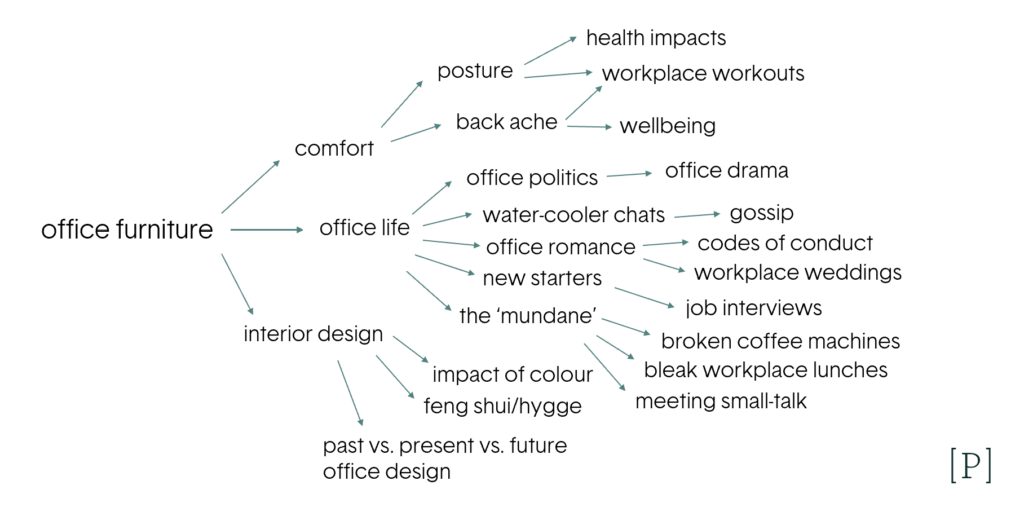
From this alone, you could start ideating, but to take things a step further and help you build out even more related topics or concepts, there are a range of different online tools you can use. These include BuzzSumo’s Content Ideas Generator, the Semrush Topic Research tool, or Answer The Public. Using these tools, you can input your core product, e.g. ‘office furniture/office chair’, or some of the topics you’ve mind-mapped, e.g. ‘office romance’, and see what comes up.
Semrush’s Topic Research tool will help you find trending content ideas tailored to your subject. For example, if you search for "office furniture," you might uncover content like "Sustainable Office Design: The Rise of Eco-Friendly Furniture," which steers you towards the growing interest in sustainability in workplace design. This insight alone can provide a springboard for ideas that will actually resonate with current market trends and client needs, rather than getting stuck with a boring old swivel chair to ideate around.
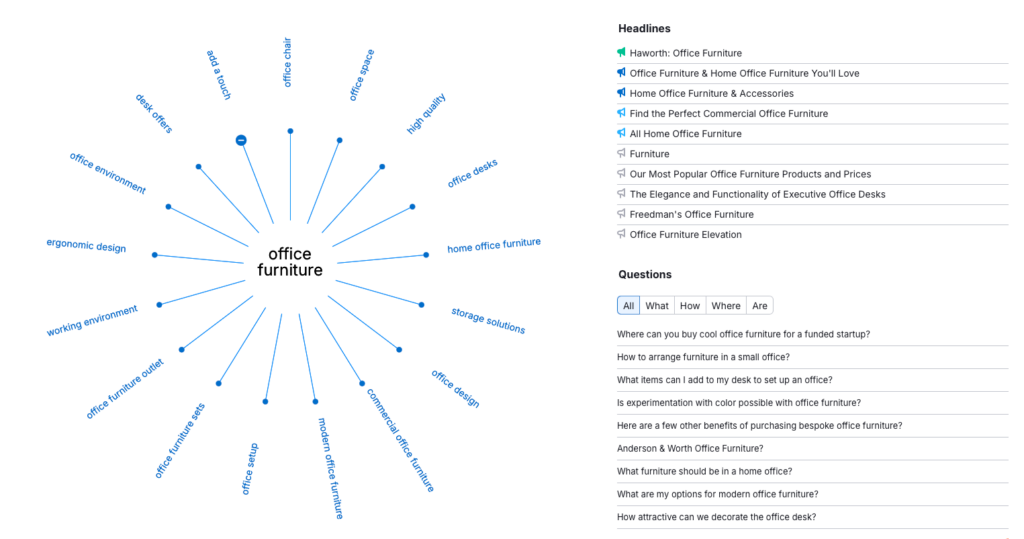
On BuzzSumo, you’ll find top performing content based on subject, which can again provide more inspiration: a simple search of ‘office furniture’ threw up this New York Times piece on where office furniture goes when no one wants it, steering you into the realm of recycling, upcycling, and what could be possible for your client in that space straight away.
Meanwhile, Answer the Public shows you what people are searching for around your core topic. Insights which can be mined again and again on each of the topics you’ve mind-mapped, helping you to both learn more about your audience and potentially uncovering some valuable insights to use in your ideation.
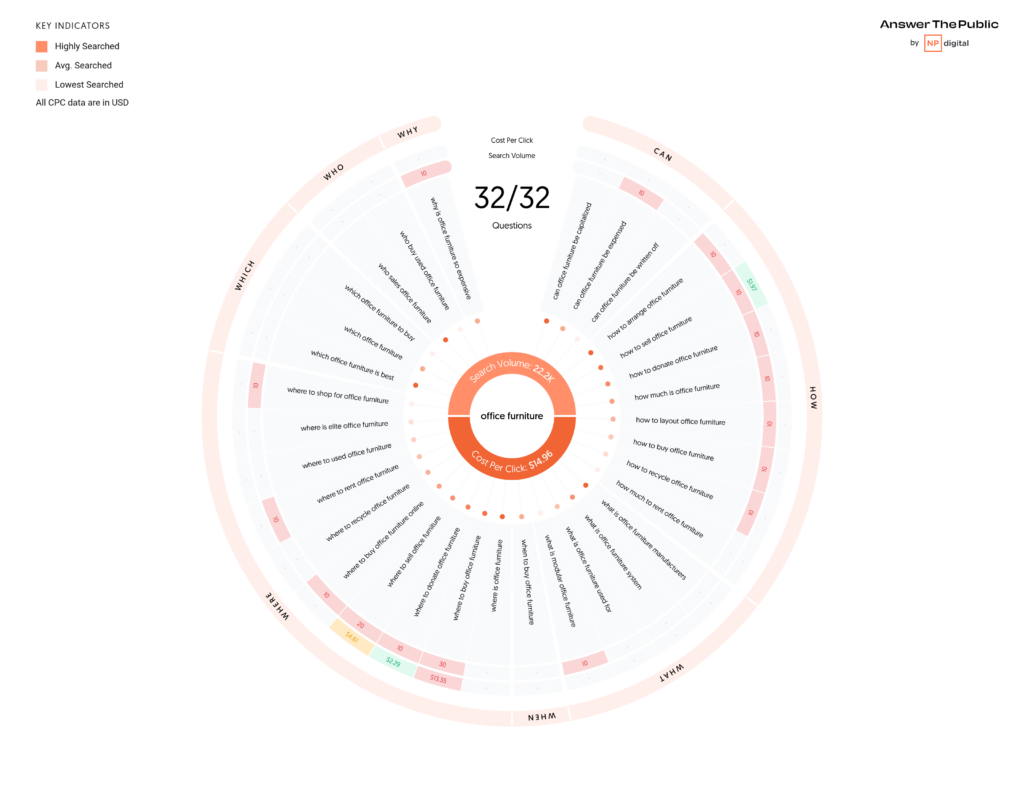
The first step when coming up with ideas for any client, whichever end of the boredom-scale they fall on, should always be one of exploration as you get your head into that world. Working outwards from the core product can be a great way to kick this off.
#2. Magnify a niche element of your brand
On the flipside, a tactic I use a lot is focusing on something about the product or offering at a really in-depth level. All to uncover something that could become an idea in itself. Because while certain things might seem dull at first, there could actually be something hyper-relevant to your client’s business or product that you just haven’t considered yet which could be the launchpad for an entire campaign.
To use an example from my own experience: we work with a client that specialises in scrapping cars which, on the face of it, isn’t the most exciting subject. However, through taking the time to learn more about car scrappage, how it works, and learning from the client, we learnt that certain parts of cars (namely the metals found in ‘catalytic converters’) are recycled and often turned into jewellery, including wedding and engagement rings.

When paired with the fact that we also knew that some people develop a serious bond with their cars, or simply love cars in general, this niche nugget of information became the basis for an entire campaign.
We partnered our scrap client with a jeweller to give petrolheads the chance to create wedding or engagement rings from parts of their old scrapped cars. As some cars can play a big part in a couple’s formative years and may play host to memories of road trips and first dates, the campaign resonated very well, and got our client covered by the likes of Forbes, key motoring titles, and even wedding publications, which they would otherwise never have been able to gain coverage or links from.
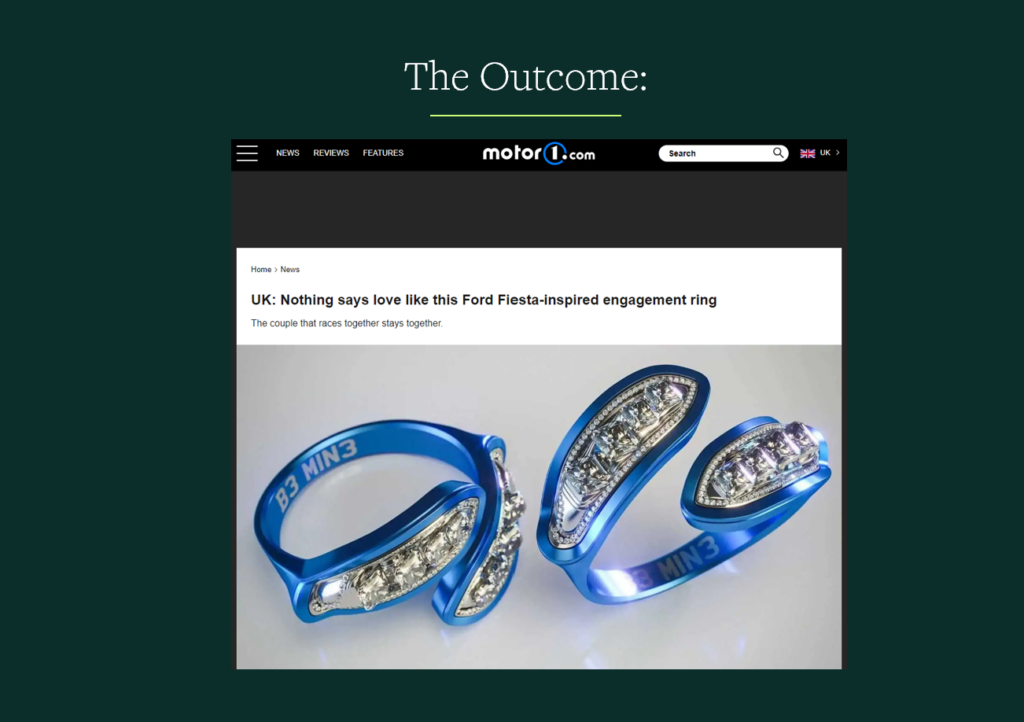
This was all thanks to taking the time to learn a bit more about car scrappage and really focusing on a niche element of it that many people are unaware of. This is a great example as to why you should always ask your client as many questions as possible and aim to learn about their world, as there could be a similar opportunity awaiting you.
After learning these little niche nuggets of information, I’ll ask myself the question ‘What if this thing was the main focus of the campaign?’ and see where it takes me. When partnered with another, broader insight (such as the strong connection some people have with their cars, as used in the example above) you could be onto something.
#3. Partner up with a more ‘interesting’ subject
Speaking of partnering things up. If neither of those tips are working for you and you’re finding yourself lost in how mundane the subject you’re facing may be, a tactic I almost always find to be a winner is to pair it up with something that definitely is ‘interesting’ on a mass scale.
Wondering ‘What if we brought music into the equation?’ or, ‘What if the idea was based around art or illustrations?’ or even, ‘What if my ‘boring’ client collaborated with one of my ‘dream’ clients?’ are just a few questions you could be asking yourself in order to come up with something that’s a bit more unique.
This might not lead you to the finished article, but can immediately help you spice things up and take your base subject matter in new directions — and, most importantly, in a direction that more people are likely to find interesting.
The way I often do this is based on ‘random topics’. Simply having a long list of random topics, from children’s toys to politics, influencers to streetwear, and thinking of what stories we could create if I paired my client up with that topic. Here’s 10 to get you started — it can be amazing what thinking of a completely different subject during your ideation can result in.
- Landmarks
- Hygiene
- Conspiracies
- Wildlife
- Fashion
- Poetry
- Memes
- Make up
- Space
- Video games
This might sound like chaos, but I find it to be a really useful way of overcoming the imaginary barriers you might have created because you weren’t immediately inspired by the core subject.
Bringing this back to the office furniture example I mentioned above, simply bringing music into the equation could bring about ideas around office disputes caused by music choice, or finding what the ‘swear-threshold’ is for an acceptable workplace playlist. All these ideas could make sense for your brand, as you have a space to talk about the office environment as a whole, and not just the furniture in it.
Starting to ideate around subjects you’re actually interested in can also breathe life into what could have otherwise been a challenging brief, so it’s a win-win!
#4. Embrace the ‘boring’
Despite there being so much value in taking your brand to new places and bringing it to life in exciting ways, I do think as marketers we can often hold ourselves to the pressure of every single story being something you could shout about on social media or submit for an award a little too much.
Of course our output has to work and get results, but that doesn’t mean that we need to reinvent the wheel and produce the most creative thing you’ve ever come up with every time. It feels weird saying it as someone who loves big, shiny ideas, but sometimes, with certain brands and certain objectives, you just need to embrace the boring.
A media-friendly story could be staring you in the face, but because you deem a certain brand or product as ‘dull,’ you could be missing it. Journalists need to cover more straightforward topics too and some simple advice from your client (the expert on the subject) could be all you need. Be it cleaning advice, opinions on a law related to your product, or some interesting internal data, there’s tons of opportunity for most brands on the surface level.
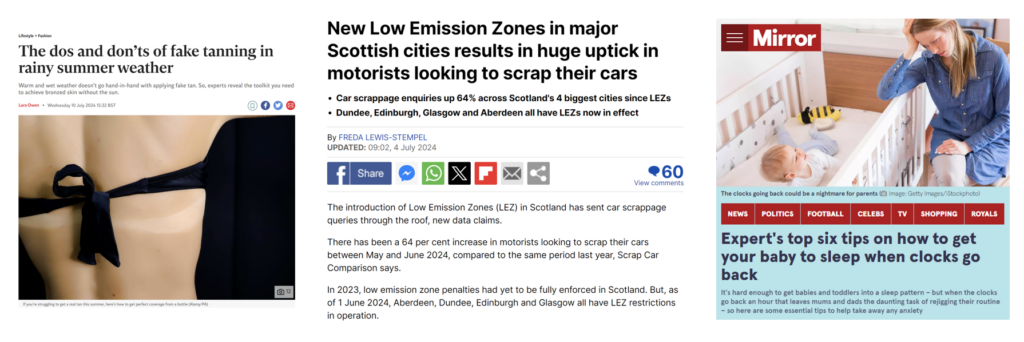
Again, tools like Answer the Public and BuzzSumo can be great at highlighting what people are searching for and what the media is writing about around your topic, which can in turn highlight areas for using brand data, presenting new research, or publishing some simple commentary.
I also love using Reddit for this. There’s a subreddit for almost everything, and while the content of your brand’s offering might not be something you’re personally interested in, someone else surely will be. These subreddits provide a great window into what people are discussing, what interests them, and what experts are saying. This helps you identify areas related to your client and develop them into media-friendly stories.
Once you’ve created your story, and as these topics can often be quite niche, it’s worth exploring tools like Prowly's Media Database, which allows you to search for journalists who cover your specific topic. With this, you can curate a media list that will genuinely be interested in your story. If you need to narrow down your search to find the most relevant contacts, you can:
- Search media outlets where your target audience is active, then follow up with the contributing journalists.
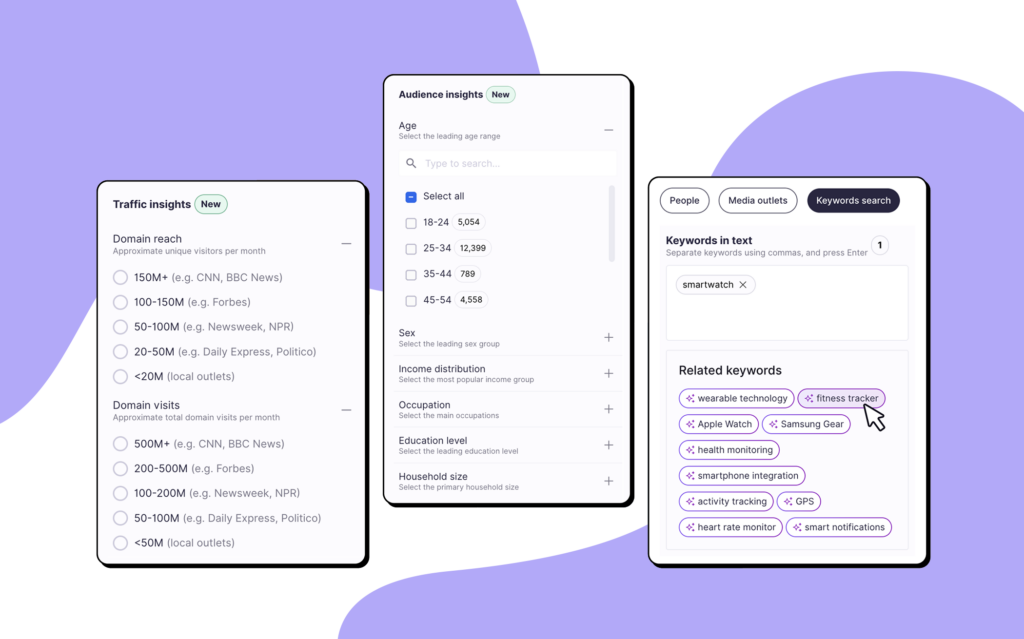
- Search for articles using your keywords (expanded with AI-generated suggestions) and get in touch with authors writing in your niche.
#5. Build trust
Finally, while you might have come up with a campaign idea you just know will work and is something geared to take your client from a somewhat niche industry to gaining mainstream media attention, it goes without saying that getting them to go for it will take some trust.
If they’re going to be putting their brand out there (and spending money to do so), they’re going to need to be confident. So how can you build the trust required to actually execute the ideas you really believe in?
- Play the long game: Trust is something that is built over time and if your idea doesn’t have to be launched right now, it could be something worth saving for the future. Start building trust with other activities, rather than ‘scaring’ anybody with an idea that might seem a little out-there in your very first meeting.
- Back it up: While you, as a PR, might know why your idea will work with the press, your boss or client might not. Be sure to back up your ideas with examples of similar campaigns which have been successful to help cement its validity. These can be from previous projects you’ve run to similar stories in other industries.
- Relay the objectives: If your idea is ‘perfect’ it should connect with the objectives you’ve all agreed upon upfront – from media targets to brand tone – so when presenting the idea, be sure to take them on a journey that reminds them of all of these objectives, positioning your idea as the solution that ticks off all of the markers. After that, how can they say no?!
To summarise, any brand can be made interesting, exciting and be able to land newsworthy features. Sometimes you just need to look past your initial perceptions, because that oh so boring brand might end up being the ‘dream’ client you’ve been looking for all along.
Looking for a comprehensive all-in-one PR tool?
Try Prowly completely free for 7 days in a platform with everything you need for PR.
- All-in-one software: Get everything you need in one tool for PR, incl. media database, outreach, reporting, and more
- Transparent pricing: Plans start at $258/month
- Comprehensive monitoring: Track the web and social media mentions.

